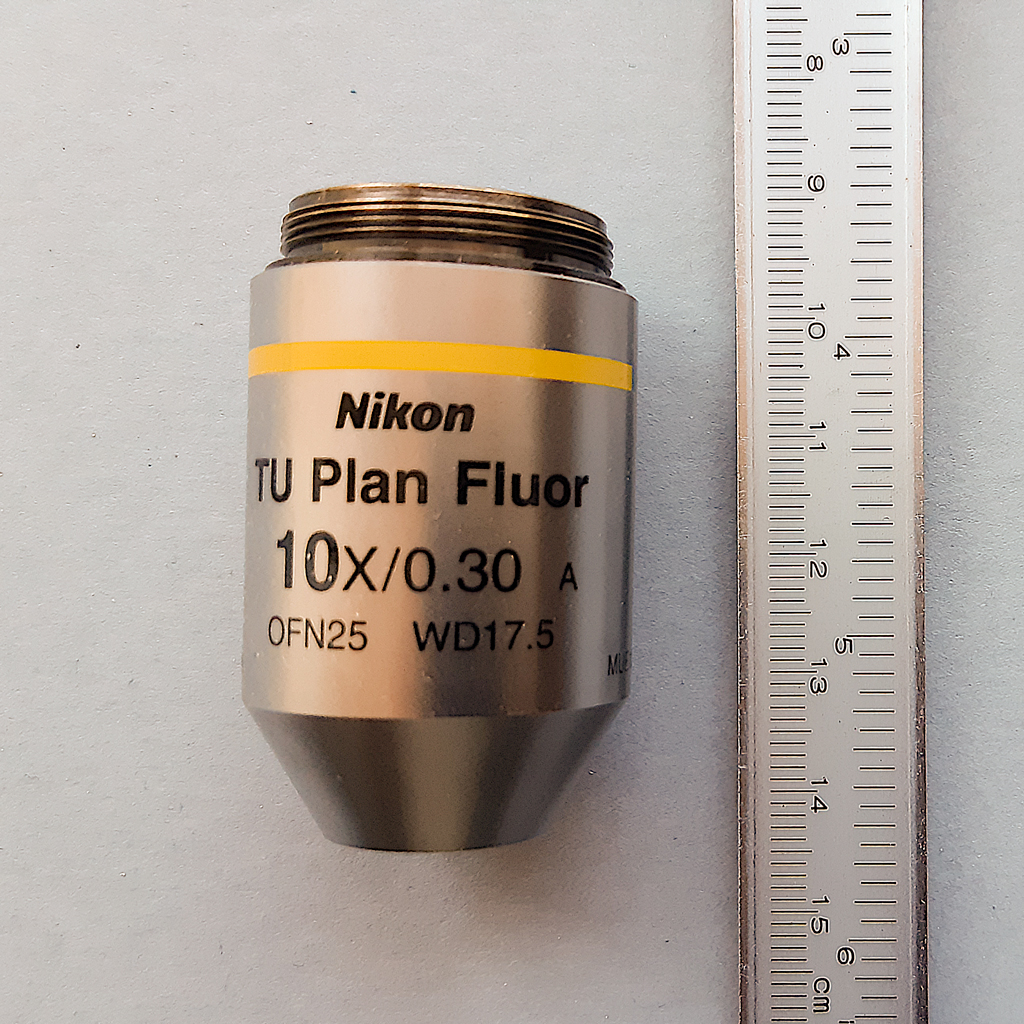A short introduction to microscope objective lenses and the information printed on them
The enlargement is straight forward. 5x (red), 10x (yellow), 20x (green), 40x (blue) and so on shows how much the subject will be enlarged if the objective is used as intended. Using a 20x objective on a 1mm subject will enlarge it to 20mm on the camera sensor.
The next number is usually the numerical aperture (NA) for example 0.14. This value can be used to calculate the resolution (r) and the Depth of Field (DOF). Resolution is the smallest object that the objective can resolve and the DOF is the largest step size that can be uses for focus stacking. Read more about NA and Depth of Field (DOF), read more about resolution.

Infinity (∞) objectives are intended to be used in combination with another lens – a tube lens. This can be a lens made specifically for this purpose, but a camera tele lens with the correct focal length focused at infinity can work just fine. An objective with the marking 5x, ∞ / 0 and f = 200 printed on the barrel means that the objective will enlarge the subject 5x on the sensor if used with a tube lens with focal length 200mm focused at infinity (∞). The null (0) means that this objective is optimized to be used without a coverslip (coverslip thickness = 0 mm).
Some objectives have the working distance (WD) printed. The WD is the distance from the front of the objective to the subject in mm when the objective is used as intended, in this case 17.5mm. If there is an OFN number this shows the intended maximum field of view for the microscope eyepiece, in this case it is 25mm. Usually, but not always, the image quality falls quite quickly outside a circle with the diameter of the OFN.

Note: You have to test and evaluate
Microscope objective have a quite narrow good image circle. You have to test and evaluate to find out what is ok for you.
Note: It can be necessary to use different focal length tube lenses
Say that we have an objective with OFN 25mm and a corresponding 25mm good quality image circle that we want to use on a full frame (FF) 24mm*36mm camera sensor. To match the FF sensors 43,3mm diameter with the 25mm image circle the image has to be enlarged at least 1,73x (=43,3mm/25mm). A tube lens with a focal length of 350mm will enlarge the image circle 1,75x (= 350mm/200mm) and do the job. In a microscope the enlargement of the image circle is done with a projection lens, usually a 2.5x lens. It is also possible to scale down the image with a shorter tube lens. This can be useful when the image circle is larger than the sensor diameter.

Finite (non-infinity ∞) objectives can be marked with the intended tube length measured as the distance in mm between the shoulder of the microscope lens to the shoulder of the microscope ocular. In this case it is 210mm. The distance between the microscope shoulder and a camera sensor is shorter – usually but not always 10mm shorter. So 160mm is 150mm to sensor, 210mm is 200mm to sensor and so on.
Using a finite objective that is intended to be used without a coverslip such as the 210/0 lens above is the same thing as using a camera objective on a bellow. But a high NA objective as this 0.80 objective is quite sensitive to the wrong tube length.
Microscope photos of a butterfly scale to show the difference between the correct 210mm tube length and 160mm tube length when using a Nikon M Plan apo 40x NA 0.80 on a microscope. A 2,5x projection lens is used – so this is 100x (= 40*2,5) on sensor. 210 mm tube length viewed at 200% and 160mm tube length viewed at 300%. The red arrows show the place in focus.


Objectives that are made for a coverslip have the intended coverslip thickness in mm after the infinity (∞) mark or after the tube length number. This is usually the standard 0.17mm. A “-” means that it works with no coverslip, this is usually the case for low NA lenses say up to NA 0.2. Some lenses can be adjusted to be used with coverslips of different thickness. In this case the lens is marked ∞ /0-2 so it works with no coverslip, a normal coverslip and can be used to view through the bottom of a glass petri dish that is up to 2mm thick.